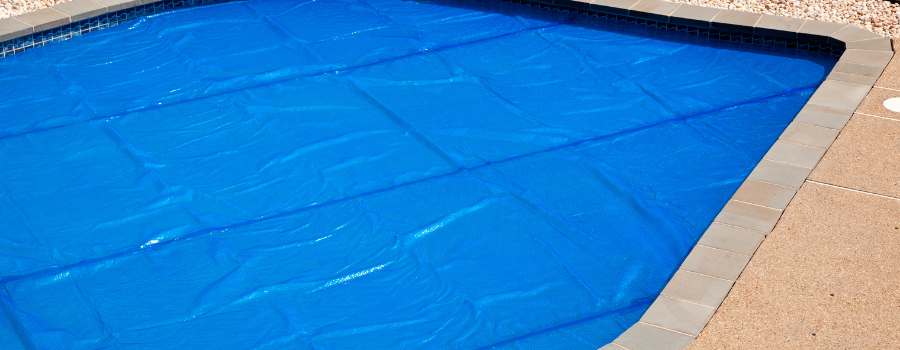Keeping your pool heated to a comfortable temperature can be costly…even in the summer when the suns rays are doing a lot of the work for you. But, there may be a way to get a few extra degrees to help take that chilly edge off…solar heating blankets!

What Is A Solar Pool Heating Blanket?
A solar pool heating blanket is a large sheet of air-encapsulated polyethylene bubbles that sits on top of the water in your pool and helps to heat it up with the heat from the sun. The blanket works by trapping solar energy and transferring it into the pool’s water, which is then circulated around to keep temperatures warm. Solar pool blankets are relatively inexpensive and easy to use, making them an attractive choice for pool owners looking to save money on their energy costs.
Do Solar Pool Blankets Really Work?
Generally speaking, if you make sure to cover your pool with a solar heating blanket when it isn’t in use, you should be able to see an increase in temperature anywhere from 3-5 degrees. Ambient temperature and size of your pool can make this range vary.
In short, a solar blanket can help you keep your pools temperature up without having to run the pool heater constantly. The long answer depends on a few factors, such as the size of your pool, how much sun it receives during the day, what type of solar blanket you have and other variables.
What’s The Difference Between A Solar Blanket and A Solar Pool Cover?
Although they both function to add warmth to your pool, solar blankets and solar pool covers are very different in terms of their construction, cost and effectiveness.
While a solar blanket is made from air-encapsulated bubbles that help insulate the pool water and trap solar heat, a solar pool cover is constructed of solid material that traps heat within it but does little to insulate the pool itself.
Solar blankets are usually much more cost-efficient than pool covers, and they can be used both day and night while pool covers typically have to be removed when the sun goes down.
How Long Does It Take For A Solar Heating Blanket To Warm Up A Pool?
On average, you should expect to see an increase in temperature of 3-5 degrees within the first few days of using your solar blanket. Some people claim to get upwards of 15 degrees in that time.
The amount of time it takes for a solar heating blanket to warm up your pool will depend on several factors, such as the size of the pool and how much direct sunlight it receives during the day.
To maximize the effectiveness of your solar blanket, make sure to cover your pool when it’s not in use and keep an eye on the temperature throughout the day. With proper care and maintenance, you should be able to enjoy a comfortably warm pool all season long.
What Are The Cons To Using A Solar Heating Blanket?
Although solar pool heating blankets are an excellent way to save energy, they do come with a few drawbacks.
For one, the air bubbles in the blanket reduce visibility and can make it difficult to spot debris or other objects that may have fallen into your pool while you weren’t looking. And since the blanket must be removed when swimming, there is the risk of it being damaged or blown away if not properly secured.
There is also the risk of excess algae growing if your pool is covered for longer periods of time. One solution is to leave a portion of the pool uncovered so that the water receives a bit of agitation for the wind…of course, this will greatly impact the efficiency of the blanket.
Can A Solar Heating Blankets Handle Snow?
Yes, solar heating blankets can handle snow. The air-encapsulated design of the blanket still allows it to absorb heat and transfer it into your pool’s water, regardless of whether there is snow or not.
However, when snow accumulates on top of a solar blanket it increases its insulation value which can reduce the amount of heat that is transferred into the pool’s water. If you live in a climate with frequent snowfall, it may be wise to invest in a solar blanket specifically designed for snowy conditions.
